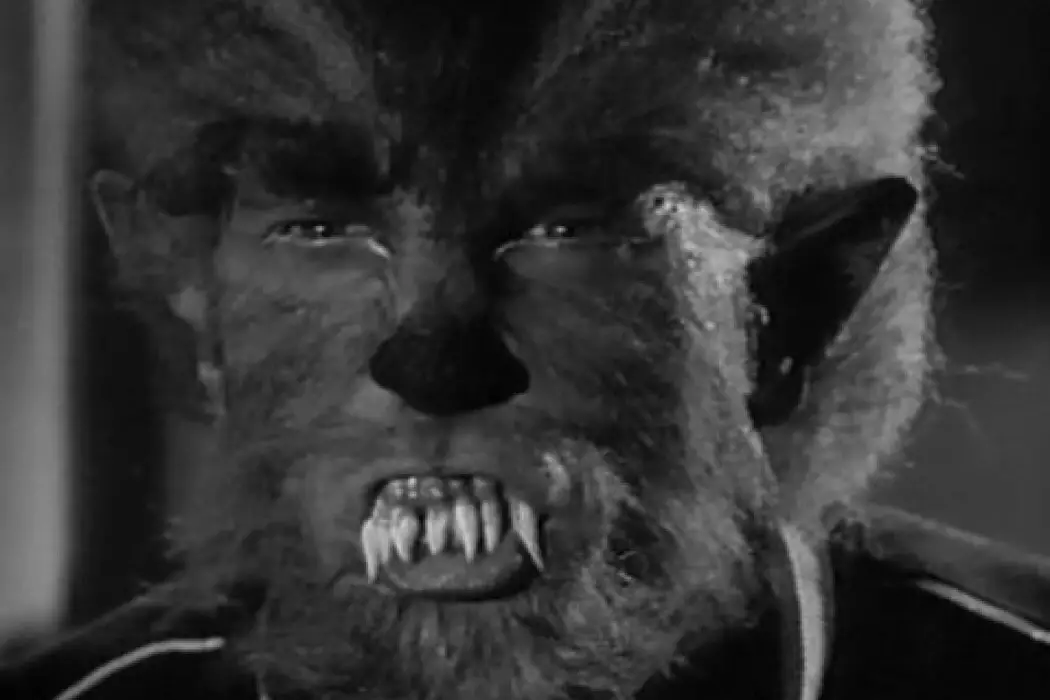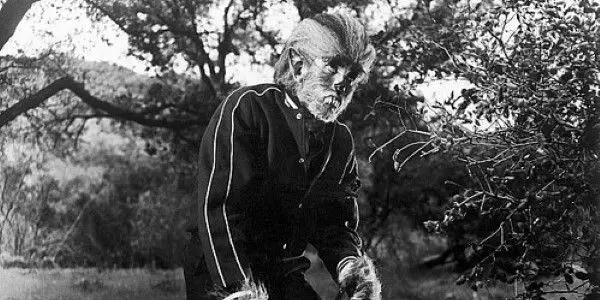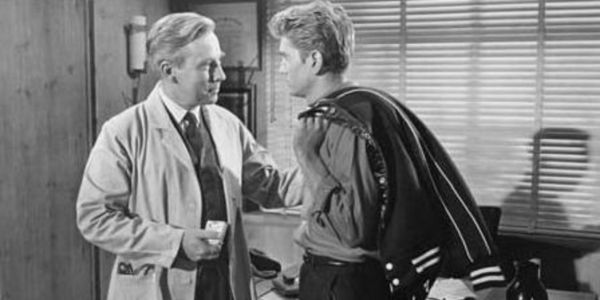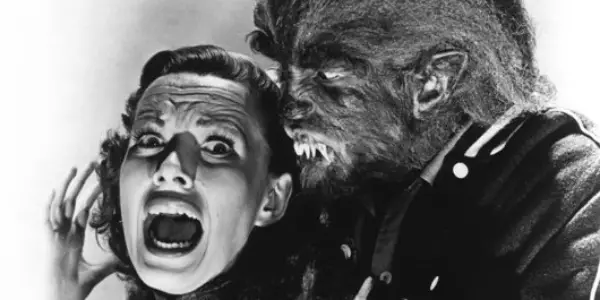Werewolves & Lobsters: How I WAS A TEENAGE WEREWOLF Explains Jordan Peterson’s Appeal

Danny Anderson teaches English at Mount Aloysius College in PA.…
It’s a campy, low-budget drive-in flick, but director Gene Fowler’s 1957 magnum opus I Was A Teenage Werewolf remains a lot of fun. Before Bonanza and Highway To Heaven, young Michael Landon does his best James Dean impression in this tale of an “Angry Young Man” trying to improve his attitude but who becomes a lycanthrope instead.
This movie does not aspire to be “Great Cinema”. It is a teen exploitation film with a low budget that was a massive drive-in theater hit in 1957. It’s understandable that people who care about taste might not take the movie very seriously today. However, I recently re-watched it and something about this film seems eerily reminiscent of a current situation in our culture. And I wonder if, despite the overt silliness of I Was A Teenage Werewolf, it might give us a useful way to think about the cultural impact of one Dr. Jordan Peterson.
I Was A Teenage Werewolf
Like almost all werewolf movies, I Was A Teenage Werewolf is at its heart a melodramatic tragedy. Landon portrays Tony Rivers, a likable 50s high schooler who nonetheless has a desperate anger problem. His character emerges straight from the Angry Young Man archetypes of the 1950s, down to his haircut, and the film opens with him in a schoolyard fight with another student. Sympathetic police detective Donovan (Barney Phillips) intervenes and sees a good boy buried somewhere deep in Tony’s heart. Instead of arresting him, he urges Tony to see local psychiatrist – Dr. Alfred Brandon (Whit Bissell). Unbeknownst to our well-meaning detective however, Dr. Brandon is a variation on the classic Mad Scientist archetype and is hatching a plan to save humanity from the horrors of progress by regressing it back to its primitive state through hypnosis. Tony is gradually regressed to the point where, under certain stressful pressures, he transforms into a werewolf (in one of cinema’s more memorable werewolf makeup designs).

Landon’s performance is committed and impassioned, and Bissell’s is gloriously campy, making the pairing memorable and compelling. When looked at from a certain angle, the relationship between Brandon and Tony also weirdly resembles the connection between Jordan Peterson and the disaffected, angry young men of our own day.
Who Is Jordan Peterson?
Since his rise to prominence as a critic of political correctness and its impact on the use of gendered pronouns, the Canadian psychology professor has established himself as a leading figure in the so-called “Intellectual Dark Web”. The largely (though not exclusively) conservative movement vociferously advocates for unlimited free speech and pushes back against perceived restrictions of progressive cultural and political movements. If you hear someone talking about “logic and facts”, there is a good chance they share IDW sympathies. The movement also rails against postmodernism and Marxism (and bends over backwards to equate the two, defying all logic and facts).
Peterson himself is a Jungian evolutionary psychologist and became a sensation on YouTube with videos advocating supposedly traditional conceptions of masculinity and lamenting the fallen state of contemporary society where, as he sees it, men are not men and personal responsibility is a heap of ashes in postmodernism’s wake.
Peterson’s arguments often rely on mythological readings of texts like the Bible to describe Jungian archetypes of masculinity and the good life. He also sees lessons for a well-ordered society in creatures like the lobster, that viciously enforces social hierarchies and which therefore, for some reason, offer a model for a well-ordered human society in Peterson’s view.

His speeches and interviews made Peterson an intellectual celebrity and his ideas eventually took form in a book, 12 Rules For Life. His work has found a vast, dedicated following, particularly among young men who have become disillusioned about society and who seek meaning and purpose for their lives. Peterson frames the book as an antidote to “chaos”, and it essentially frames the world as a cruel scene of existential struggle in which only the strong will survive. His twelve rules are presented as preparation for this hostile world in which lobsters eat one another on the path to material success and emotional adjustment.
The book was released in 2018, and Peterson’s star has not diminished. There is a documentary about him about to be released and he is apparently starting a “free speech” version of Twitter.
Peterson’s Reactionary Primitivism
Peterson is clearly on to something. Whether his solutions are helpful or monstrous is another question. Something in society has left a spiritual hole in wide swaths of the population and terrifying numbers of young men are rudderless and clamoring for meaning and stability. Some people might point to the de-humanizing and alienating effects of capitalism as a source of this discontent, but men like Peterson place the blame on the weakening of the male in society. In short, 12 Rules For Life speaks to men who want to be warriors who make life meaningful through trial by combat.
Tara Isabella Burton describes Peterson’s project as a form of paganistic atavism. She argues that Peterson is part of a long tradition of thinkers who believe the person (particularly men) thrives more fully through a process of survival of the fittest. And though Peterson claims to seek a society that is more enlightened and civilized, what that looks like is a civilization of men climbing on top of one another in a quest for dominance.
Werewolves and Lobsters
Whit Bissel’s Dr. Brandon bears a resemblance to Peterson in a few obvious ways. Obviously, the two figures both work in the field of psychology and the mental state of youth is their primary focus. Second, both men propose a form of atavism, a return to ancient things, as the remedy for society’s chaotic ills.

Detective Donovan sends Tony to Dr. Brandon because of the psychologist’s previous work with the police. Donovan sees the directionless rage in Tony and firmly believes that Brandon can help him adjust to civil society. Unfortunately, Brandon sees no hope in society as it has progressed. Explaining his plan to his assistant, he says “mankind is on the verge of destroying itself. The only hope for the human race is to hurl it back to its primitive dawn”. For Brandon, modern society has pulled man too far from his primitive origins, robbing him of the power to hunt, dominate, and kill in a quest for supremacy.
Compare Brandon’s ideas with Peterson’s. The evolutionary psychologist points not to the wolf, but rather to the lobster as evidence for the naturalness of brutal hierarchies for an ideal human society. When pressed on his idealization of lobster society in a famous Channel 4 News interview, Dr. Peterson evokes Dr. Brandon, saying that his advice to “stand up straight with your shoulders back” is “an injunction to be combative”. He goes on to talk about the naturalness of social hierarchy, denying its origins as a social construction of patriarchal society. For Peterson, like Dr. Brandon, it is the natural state of man.
The Monstrous Male
A third commonality between our two doctors is their target audience: young men who feel emasculated by modern society. Peterson appeals to his audience in part because he lays the blame for its discontent at the feet of feminism, Marxism, postmodernism, any ism, all the isms. They are angry because they are not allowed to be angry.
Likewise Tony is taken to Dr. Brandon because he is violent. Brandon’s solution is to make him catastrophically violent. Essentially Tony’s problem isn’t Tony, it is that society won’t let Tony be Tony, and society must therefore regress to its hierarchical, lobster state.

And who is this rage carried out upon in the film? First, a weak man. After his first transformation, Tony attacks and murders his friend Frank (Michael Rougas) in the woods. Frank is depicted as a meek, unassertive young man who most definitely does not stand up straight with his shoulders back. He slouches through the woods on the way home from a party in which he did not try and pick up any girls and werewolf-Tony murders him while he cries and begs for his life.
This is the alpha male at work, and like a good lobster, his success is derived though physical force brought down on weakling.
Tony’s other notable victim (aside from Dr. Brandon himself at film’s end) is the young woman practicing gymnastics after school. Tony stumbles upon Theresa (Dawn Richard) as she works on the parallel bars and stands at a distance leering at her. The scene is a good example of what film scholars often call the “male gaze”, and Tony’s intense look is not one of admiration but lust. Standing next to a school bell, he is shocked into transformation when the bell rings next to his ear. Tony’s lust turns to murder when he assumes his regressed form.
The cost of reclaiming man’s “natural state” of hierarchical power is a young woman’s life.
Certainly Jordan Peterson has tapped into some real problem in society. Alienation is real and people feel a sense of purposelessness. His legion of fans and admirers excitedly consume his message in order to find meaning. The seemingly disposable drive-in werewolf flick I Was A Teenage Werewolf offers a surprisingly profound warning about the dynamics underlying this fandom.
Does content like this matter to you?
Become a Member and support film journalism. Unlock access to all of Film Inquiry`s great articles. Join a community of like-minded readers who are passionate about cinema - get access to our private members Network, give back to independent filmmakers, and more.
Danny Anderson teaches English at Mount Aloysius College in PA. He tries to help his students experience the world through art. In his own attempts to do this, he likes to write about movies and culture, and he produces and hosts the Sectarian Review Podcast so he can talk to more folks about such things. You can find him on Twitter at. @DannyPAnderson.













